Day |
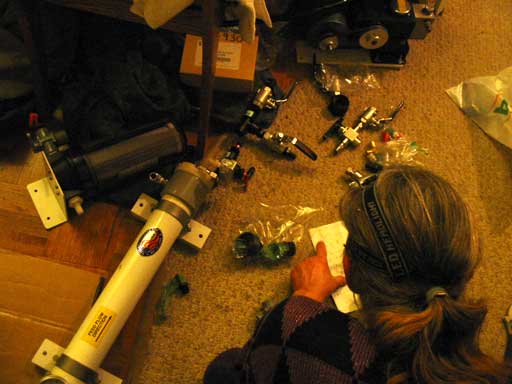 |
More Water System, new foot
locker |
| It seems like
only yesterday when we chose the design of our boat, received the plans
by mail, and poured the concrete pad on which to build her. It was 365
days ago but those days were in between others totaling over 7 years. It
would have been nice to get this far in one year, if we'd had an
unlimited supply of money and were robots with no back problems, it may
have been possible ha ha! Gena, on the other hand, thinks it may have been possible because so much time is spent on setting everything up and pulling all of the tools out after sitting in the sheds all week as well as weather related issues. She may have a point there. If we were to do it all
again, there would be several changes: We didn't celebrate or
anything, we'll save that for the launch party, but we have a definite
boost to keep going as it's not much further now! The whole neighborhood
and all of you online are waiting for that day. It will come soon. We
promise :) |
|
| Back to work, the photo to
the right shows insulation tape around the hot water line which, even
though only uses a couple of cups over the long run, will loose a lot of
heat on the way. Of course the tape wouldn't stick to the hose. At all.
Why would it? Tape was coiled around it instead. Maybe it'll anneal to itself...eventually. The hot water system is an elaborate thing for a sailboat, but could come in handy. On a cold morning after a miserable night, a hot shower or bath might hit the spot. It does for me on land. The hot water will come from 2 sources, the engine ( which won't be started *just* for this purpose ) and the overcharge load diverter -or just switched on from battery power. Load diversion is a great method of using otherwise wasted energy from nature. The solar panels, water generator, and wind generator all have the capacity to over charge the batteries if the current isn't being drained off as fast as it is being generated. Diverting excess charge to the water heater is a convenient way of using this energy. The water heater with a 12 volt element could kill one of our 4 batteries in 4 hours, but it would never take much more than 20 minutes to bring the water to temperature. Enough to have a shower. Basically this is an automatic system in two ways, if the batteries get to the overcharging voltage, the diverter kicks in and takes the top off. The second way is if we want to have a hot shower, we must not use the computer ( bad in a sailboat! ) or watch TV ( equally bad ) or the batteries may not make hot water ha ha! Joking aside, what if the hot water tank reaches temperature and shuts off? An alarm buzzer we are installing across the element thermal switch will warn us of this and one of the charging sources will need to be shut down. |
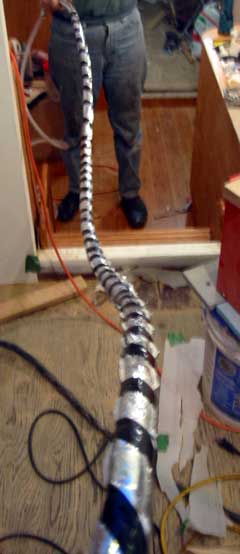 |
| The engine, like it or not, will also be able to charge the batteries, as well as its' own battery. As above, we won't be running the engine exclusively for charging the batteries. Fuel is much to expensive for that! I'd rather use a wind-up radio and flashlight all night thankyou. | |
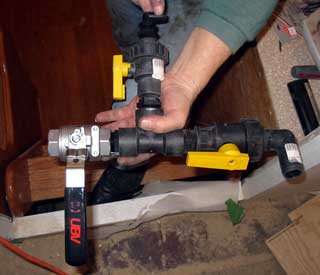 |
(Photo
left) Gena proudly displays her latest valve contraption that has to do with
the salt water intake side of the system. A full explanation will be
provided tomorrow. ( Providing she gives me the promised outline of the
system by then! ) I am totally lost when it comes to pipes and fittings even
though I can design and build just about anything electronic. Weird huh? The top of the page photo may intimidate even a plumber with all of those adapters and fittings. I do know that some of the pumps are being a problem to find conventional adapters for. I always say RV threads or home threads, RV sizes or home sizes. It seems like a conspiracy. Once an RV / marine plumbing part is employed, it seems like one is forced into using *everything* RV/Marine.... |
||
| As
can be seen below, my job was to build the foot locker at the end of the
forward berth. Notice how the ply is routed into the oak board. I like to do
this because it ends up looking good and strong as well.
The old bulge in the sail locker
bulkhead came back to haunt me during this project. The reason there are no
top frames is because our antique sewing machine wouldn't fit in there
otherwise. It has it's own box and is really cool so it had to
fit! I am made a neat latch experiment at work for this locker but forgot it there so it'll be installed next weekend, on another day. |
|||
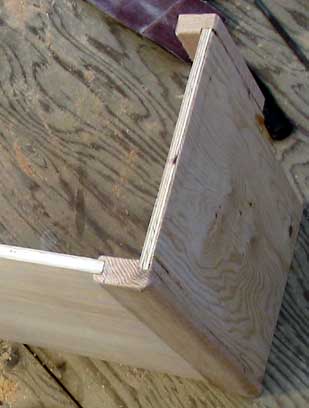 foot locker ready to go in |
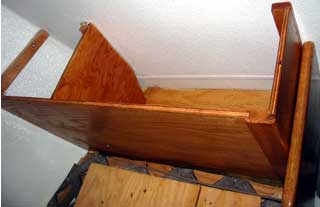 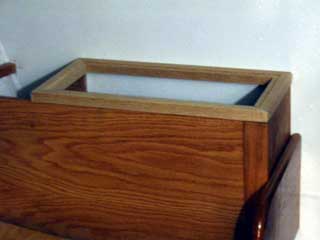 |
||
| Gena had to do
some coal tarring on the inside of pipe fittings and at their connecting
areas inside the stand pipes, so finally had the opportunity to paint the
mast plate. It has been useful for holding down floor sections while glue
sets etc because it is so heavy, but it's in the way and needs to go home!
|
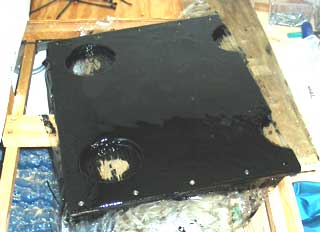 |
||
Day 365 :
365 days of sharing our project with you, our faithful readers out there all
over the planet, who have kept us going
towards our dream more times than we can mention with your emails and comments
and praise. Thankyou!
7 more hours - Built foot locker, assembled fittings for water intake, bow line
pump etc, hot water lines.